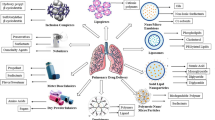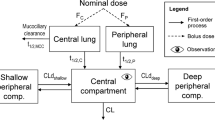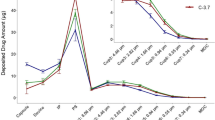Abstract
Purpose. ABT-431 is a chemically stable, poorly soluble prodrug that rapidly converts in vivo to A-86929, a selective dopamine D-1 receptor agonist. This study was designed to evaluate the ability of the AERx™ pulmonary delivery system to deliver ABT-431 to the systemic circulation via the lung.
Methods. A 60% ethanol formulation of 50 mg/mL ABT-431 was used to prepare unit dosage forms containing 40 μL of formulation. The AERx system was used to generate a fine aerosol bolus from each unit dose that was collected either onto a filter assembly to chemically assay for the emitted dose or in an Andersen cascade impactor for particle size analysis. Plasma samples were obtained for pharmacokinetic analysis after pulmonary delivery and IV dosing of ABT-431 to nine healthy male volunteers. Doses from the AERx system were delivered as a bolus inhalation(s) (1, 2, 4, and 8 mg) and intravenous infusions were given over 1hr (5 mg). Pharmacokinetic parameters of A-86929 were estimated using noncompartmental analysis.
Results. The emitted dose was 1.02 mg (%RSD = 11.0, n = 48). The mass median aerodynamic diameter of the aerosol was 2.9 ± 0.1 μm with a geometric standard deviation of 1.3 ± 0.1 (n = 15). Tmax (mean ± SD) after inhalation ranged from 0.9 ± 0.6 to 11.5 ± 2.5. The mean absolute pulmonary bioavailibility (as A-86929) based on emitted dose ranged from 81.9% to 107.4%.
Conclusions. This study demonstrated that the AERx pulmonary delivery system is capable of reproducibly generating fine nearly monodisperse aerosols of a small organic molecule. Aerosol inhalation utilizing the AERx pulmonary delivery system may be an efficient means for systemic delivery of small organic molecules such as ABT-431.
Similar content being viewed by others
REFERENCES
O. Rascol, O. Blin, C. Thalamas, S. Descombes, C. Soubrouillard, P. Azulay, N. Fabre, F. Viallet, K. Lafnitzegger, S. Wright. J. H. Carter, and J. G. Nutt. ABT-431, a D1 receptor agonist prodrug, has efficacy in Parkinson's disease. Ann. Neuro. 45:736–741 (1999).
O. Rascol, J. G. Nutt, O. Blin, C. G. Goetz, J. M. Trugman, C. Soubrouillard, J. H. Carter, L. J. Currie, N. Fabre, C. Thalamas, W. J. Giardina, and S. Wright. Induction by dopamine D-1 receptor agonist ABT-431 of dyskinesia similar to levodopa in patients with Parkinson disease. Archiv. Neurol. 58:249–254 (2001).
K. Shiosaki, P. Jenner, K. E. Asin, D. R. Britton, C. W. Lin, M. Michaelides, L. Smith, B. Bianchi, S. Didomenico, L. Hodges, Y. F. Hong, L. Mahan, J. Mikusa, T. Miller, A. Nikkel, M. Stashko, D. Witte, and M. Williams. ABT-431-the diacetyl prodrug of A-86929, a potent selective dopamine D1 receptor agonist: in vitro characterisation and effects in animal models of Parkinson's disease. J.Pharm. Exp.Ther. 276:150–160 (1996).
Y. Zheng, K. C. Marsh, R. J. Bertz, T. El-Shourbagy, and A. L. Adjei. Pulmonary delivery of a dopamine D-1 agonist, ABT-431, in dogs and humans. Int. J. Pharm. 191:131–140 (1999).
I. Gonda. The ascent of pulmonary drug delivery. J. Pharm. Sci. 89:940–945 (2000).
J. A. Schuster, R. Rubsamen, P. Lloyd, and J. Lloyd. The AERx aerosol delivery system. Pharm. Res. 14:354–357 (1997).
M. E. Ward, A. Woodhouse, L. E. Mather, S. J. Farr, J. K. Okikawa, P. Lloyd, J. A. Schuster, and R. M. Rubsamen. Morphine pharmacokinetics after pulmonary administration from a novel aerosol delivery system. Clin. Pharm. Ther. 62:596–609 (1997).
S. J. Farr, S. J. Warren, P. Lloyd, J. K. Okikawa, J. A. Schuster, A. M. Rowe, R. M. Rubsamen, and G. Taylor. Comparison of in vitro and in vivo efficiencies of a novel unit-dose liquid aerosol generator and a pressurized metered dose inhaler. Int. J. Pharm. 198:63–70 (2000).
M. Dershwitz, J. L. Walsh, R. J. Morishige, P. M. Conners, R. M. Rubsamen, S. L. Shafer, and C. E. Rosow. Pharmacokinetics and pharmacodynamics of inhaled vs. intravenous morphine in healthy volunteers. Anesthesiology 93:619–628 (2000).
G. A. Brunner, B. Balent, M. Ellmerer, L. Schaupp, A. Siebenhofer, J. H. Jendle, J. K. Okikawa, and T. R. Pieber. Dose-response relation of liquid aerosol inhaled insulin in type I diabetic patients. Diabetologia 44:305–308 (2001).
I. Gonda, J. A. Schuster, R. Rubsamen, P. Lloyd, D. Cipolla, and S. J. Farr. Inhalation delivery systems with compliance and disease management capabilities. J. Control. Release 53:269–274 (1998).
A. V. Annapragada. Biophysics of inhaled drug particles. In A. L. Adjei and P. K. Gupta (eds), Inhalation Delivery of Therapeutic Peptides and Proteins Vol. 107, Lung Biology in Health and Disease Marcel Dekker, Inc., New York, 1997 pp. 1–22.
Author information
Authors and Affiliations
Corresponding author
Rights and permissions
About this article
Cite this article
Okumu, F.W., Lee, RY., Blanchard, J.D. et al. Evaluation of the AERx Pulmonary Delivery System for Systemic Delivery of a Poorly Soluble Selective D-1 Agonist, ABT-431. Pharm Res 19, 1009–1012 (2002). https://doi.org/10.1023/A:1016559707084
Issue Date:
DOI: https://doi.org/10.1023/A:1016559707084




